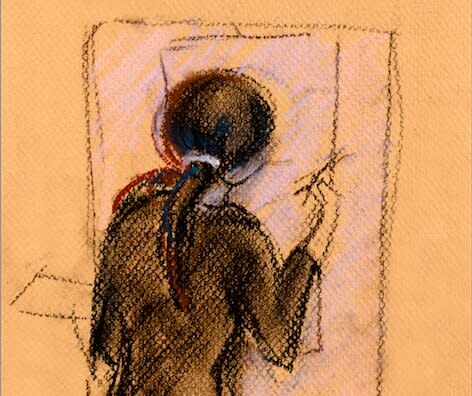What one drawing class taught me about body acceptance

Imagining that you show up to a daily activity only to find yourself totally naked has to be one of the most common nightmares. Ditto, finding yourself in the nude at the front of a classroom. And yet, that's what the models of a life-drawing class sign up for voluntarily. You would think that a life-drawing class with live, nude models would would encourage self-consciousness for all involved. But in my experience, it can actually inspire all kinds of body acceptance.
I attended numerous life drawing classes over a couple of years, and not only did it help me to improve my drawing skills immeasurably, it also gave me a different perspective on body acceptance. While some life models resemble fashion models, proportionally, more frequently they don't. This is because the real focus in life-drawing classes is learning about how to draw human bodies and movement. You want to practice sketching a variety of people, so the age and appearances of models can vary widely. Unique features (such as distinctive hands, very broad shoulders, tattoos, or a striking hairstyle) make a model extra appealing, just because they're fun to draw. You stop seeing certain features as flaws or imperfections, and start seeing them as features. They're the little things that make each body unique and beautiful.
As a student, I heard a number of different models talk about how their experiences as life models had helped them come to terms with fears they had about their appearance and being socially rejected. I also heard them discuss how enjoyable it was at the end of classes to see how people had drawn them, with every artist interpreting the model's body in different ways to express their own artistic vision. The models found the experience of working with artists highly rewarding, and they also found creative satisfaction in being able to contribute to the works of art.
Perhaps one of the most surprising things I learned while studying life drawing was that frequently the most talented life models are older men and women. This tends to be because older models often have more experience and they don't try to flex their muscles (something that is near impossible to maintain in the same pose for an extended period of time). Instead, they usually relax standing, sitting, or lying down—perhaps enjoying the occasional sip from a mug of tea as they let the artists do their work. Seeing how comfortable these people were in their own skin, and how confident they were was so encouraging and inspiring.
But one of the aspects of the classes that lingers with me most is the mood of relaxation, acceptance, and friendliness in the room as students would draw and the model would recline. It wasn't about judgement; it was about finding what was interesting and wonderful about every person and trying to represent it fully. It would be wonderful if this kind of acceptance, both of our own bodies and those of others, could spread more widely culturally. That would be a beautiful thing.
Sophie Clark is a writer from Tasmania. She wrote her thesis about fashion and gender in Pedro Almodóvar's The Skin I Live In, and you can find her blogging about fashion, movies and TV at Screen Sprinkle.
[Image via iStock]
